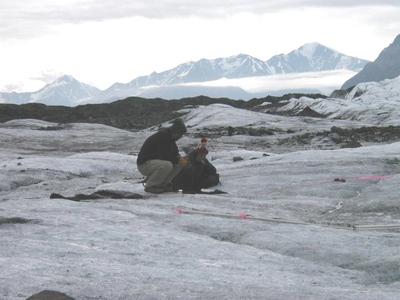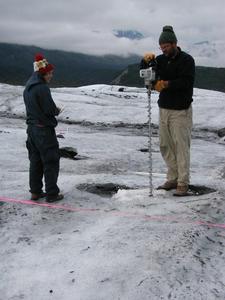
|
30 July, 2001More ablation studies and Goodbye dinner Life on ice... almost After a cold and almost dreary (it's too extraordinary to complain!) day in the field, Jeff and Staci treated us to dinner at the Long Rifle Lodge, a restaurant and lodge about half way up the valley wall (right off the highway). Nelson and I are leaving tomorrow, so it was our last hoorah before our departure. Dinner was fine and fun, and even though I've had better food in camp, the break from cooking and cleaning (parcticularly in the rain) was most welcome. One of Nelson's friends, er, colleagues from Wisconsin who joined us for dinner. Several of Jeff's acquaintances also met us at Long Rifle. When we returned from dinner, Justin, Andrea, Ranae and I played cards while others sat in the light rain in front of the fire. Jeff's mother and one of her nursing friends (who, coincidentally, is from Columbus) arrived today and shared some highlights of their adventures in their drive from Florida to Alaska over 5 weeks. After the others went to bed, Justin, Jessica (REU from last year who works at the lodge this year) and I stayed up late around the fire, talking about everything and nothing, enjoying the warmth and mesmerized by the glowing embers. Science at work Did I mention that collecting data is a critical step in the scientific process? Did I mention that collecting data is not always glamorous? Did I mention that collecting data is a continuous process... even if it is cold and rainy? Today, I worked with Ranae, continuing to collect data on how quickly the glacier is melting and how rocks on the surface of the glacier move over time. Because the CRREL guys are gone, we are collected some of their data as well. Clay has been measuring the ablation (melting) rates all summer long and tracking the motion and pedestal formation of several large boulders along the way. A light rain started about half way through our work, and made the last half quite cold. It stands to reason, I suppose; we were standing on a giant ice cube and added water. The application of moving rock data to our lives is a bit remote; it is nonetheless fascinating thing to learn about: since when do rocks move uphill? Watching the changes in the glacier over time is also quite extraordinary. Visitors who come for an hour or even a day may walk away impressed; after all, the glacier is an amazing place. People who spend days, weeks, months and even years watching and carefully observing the glacier walk away with much more: a deep understanding (or appreciation, at least) of the changing nature of the glacier and the beginning of reverence for the processes shown by the glacier. That's enough talking for now. Cheers! ~SM
Contact the TEA in the field at . If you cannot connect through your browser, copy the TEA's e-mail address in the "To:" line of your favorite e-mail package. |







